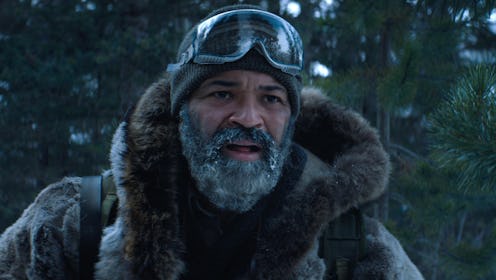Entertainment
The Story Behind This New Netflix Movie Is Incredibly Eerie
Writer William Giraldi's terse, tense book about nature writer Russell Core confronting presumptions about nature and evil in a small Alaskan town is getting a big screen adaptation, courtesy of Green Room director Jeremy Saulnier. Wolves have been snatching children in the town of Keelut, and a determined mother whose 6-year-old has gone missing read Core's work about tracking and killing wolves, and wants him to help her get revenge on the creature. But is Russell Core from Hold The Dark a real person, or just a well-written character?
Core isn't real, and he's played by actor Jeffrey Wright in the film. In an interview with Birth. Movies. Death., Wright explained his take on the character is "though he looks like a bad-ass trudging through the snow...he’s still an Everyman. The journey that he takes, he takes in relation to his having retreated on a personal level from society. In some ways, it may be that he, like a sick animal might do, heads off into the wilderness to find his end, but along the journey, he discovers redemption. There’s symbolism and mythology woven throughout the story that I think is approachable for an audience, and that approachability is through Core."
Author Giraldi's world is a bleak, dark one that's entirely of his own invention, including Core. What Wright brings is a level of humanity that's mostly missing from not only the town on the edge of wilderness, but the people making their lives there. The town Keelut is also fictional, though its name is an Inuit word that unlocks one of the key themes of both the book and the movie, that evil can take on unexpected forms, or disguise itself as something more prosaic. As angry mother Medora Slone described it, “The wildness here is inside us …Inside everything." She noted about the town itself, "There’s something off, something wrong with the sky here.”
The closest real-life version of Core's robust and confident nature-writer might be one of the great turn of the century nature writers like John Muir, who worked tirelessly to create and preserve America's national parks, yet didn't sentimentalize the wild beauty he loved. It's different from the machismo and optimistic adventuresomeness of author (and President; maybe you've heard of him) Teddy Roosevelt, though a camping trip Roosevelt took with Muir solidified both their relationships to preserving the wilderness, as National Parks Adventure reports.
Core is different; he finds himself called out at the behest of Slone, described in the book as, "trekking over the hills and the across the vale all that evening and night and into the blush of dawn with the rifle across her back and a ten-inch knife strapped to her thigh. The revenge she wanted tasted metallic.” Meanwhile Core has a far more pragmatic view, seeing the wolves not as enemies but animals, though he agrees to look for the wolf that took her son. When he can't find the child's body, he returns — and from there the movie takes an even darker turn.
Without spoiling the bleak, haunting book or film too much, Slone's husband returns from service in the Iraq war. At first seeming like the polar opposite of Keelut, with baking sun and dryness, both places are remorseless wastelands where the emptiness creates a hollow in the souls of those trapped there. Core manages to move through these spaces and find himself; Hold The Dark is what he's able to do that others gave up on.
